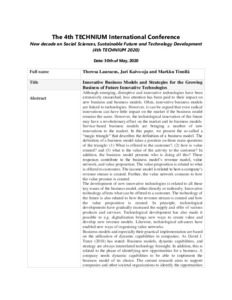Innovative Business Models and Strategies for the Growing Business of Future Innovative Technologies (4th Technium International Conference Abstract)
Theresa Lauraeus; Markku Tinnilä; Jari Kaivo-oja
https://urn.fi/URN:NBN:fi-fe2021042824825
Tiivistelmä
Although emerging, disruptive and innovative technologies have been extensively researched, less attention has been paid to their impact on new business and business models. Often, innovative business models are linked to technologies. However, it can be argued that even radical innovations can have little impact on the market if the business model remains the same. However, the technological innovation of the future may have a revolutionary effect on the market and its business models. Service-based business models are bringing a number of new innovations to the market. In this paper, we present the so-called a “magic triangle” that describes the definition of a business model. The definition of a business model takes a position on three main questions of the triangle: (1) What is offered to the customer?, (2) how is value created? and (3) what is the value of the activity to the customer? In addition, the business model presents who is doing all this? These responses contribute to the business model’s revenue model, value network, and value proposition. The value proposition is related to what is offered to customers. The income model is related to how a company’s revenue stream is created. Further, the value network connects to how the value promise is created.
The development of new innovative technologies is related to all these key issues of the business model, either directly or indirectly. Innovative technology affects what can be offered to a customer. The technology of the future is also related to how the revenue stream is created and how the value proposition is created. In principle, technological developments have gradually increased the supply and offer of various products and services. Technological development has also made it possible to e.g. digitalization brings new ways to create value and develop new revenue models. Likewise, technological advances have enabled new ways of organizing value networks.Business models and especially their practical implementation are based on the utilization of dynamic capabilities in companies. As David J. Teece (2018) has stated: Business models, dynamic capabilities, and strategy are always interrelated technology foresight. In addition, this is related to the phase of identifying new opportunities for a business. A company needs dynamic capabilities to be able to implement the business model of its choice. The current research aims to support companies and other societal organizations to identify the opportunities offered by future technology and thus promote the development of new innovative business models.
Kokoelmat
- Rinnakkaistallenteet [19207]
